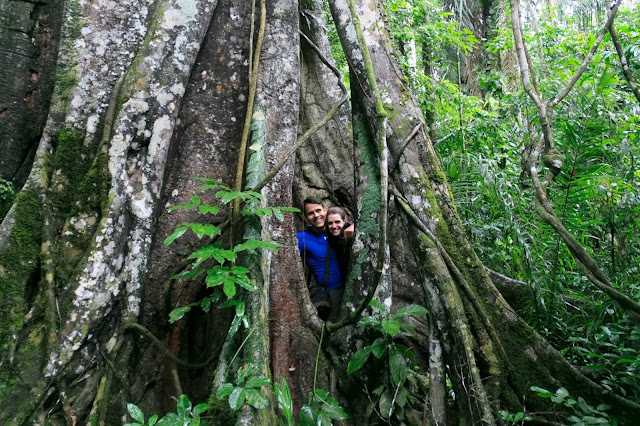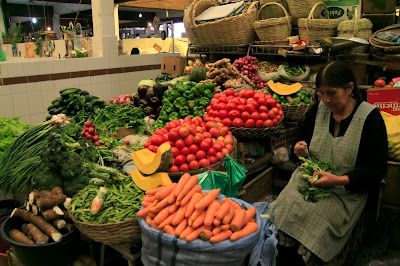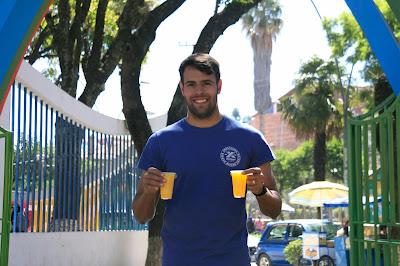Die Amasone reënwoud, die digte, geil, groen hart van Suid Amerika,
wat klop op die oer oue, onversteurde ritme van die natuur,
'n lewende, wesenlike ritme,
tasbaar in die swaar, vrugbare lug wat hang oor die oerwoud,
'n ritme van samesyn, volhoubaar en wild, met klanke wat orals is en nêrens,
'n ritme wat skuil in die skadus, fluister in die wind en wat sing in vergete tale deur die nag
'n ritme van vat en gee, van lewe en dood, n delikate balans...
dit is 'n kosbare ritme, wat ons as mens al lank terug van vergeet het...maar nooit kan bekostig om te verloor nie...
Ons is in Madidi Nasionale Park, Bolivia...hier kan onsself oorgee aan die ritme van die oerwoud, aan die hartklop van die natuur.... Albertus van der Merwe
After our overnight bus from Sucre to La Paz, we spent the morning in a coffee shop in the city center, stretching out our time (our flight was only in the afternoon) and trying to make arrangements for finding Kristi's bank card when we got back from the jungle...it got swallowed by a Bolivian ATM earlier that morning...:)
We then caught a taxi to the military airport, which was also quite an experience. Firstly it was the closest thing to driving in a local minibus taxi back home - complete disregard for the general rules of the road - but then at the military gates we were sent to three different entrances with each gate officer seemingly oblivious to the fact that there is an airport somewhere within the grounds...even our taxi driver thought it was a joke! Eventually we spoke to a more senior guy who had some recollection of there being an airport and let us in...100m from the gate there's a massive sign with 'airport turn right' written on it!?!? We felt right at home..:)
 |
| Flight from La Paz to the jungle village, Rurrenabaque. Lake Titicaca is the big blue mass on the left. |
It's a short 50 min flight from La Paz to the jungle village of Rurrenabaque, but the change in scenery and altitude is huge, you leave the dry highlands of La Paz and drop about 4000 meters to the lush and humid Bolivian jungle. We were greeted straight away by our tour company, Madidi Jungle Eco-lodge, who organised a taxi to take us into town. We stopped by the office to pay for our four day tour into the jungle and then got dropped off at our hostel...Los Tucanes, very basic but also very cheap! Budget vir die lang pad...
 |
| Rurrenabaque taxi rank |
The next morning the four of us got picked up at our hostel, and taken to the river where we boarded our ride into the jungle...a traditional long and thin dugout canoe with a propeller at the back...
It's a 3 hour boat ride up the Tuichi river to the Ecolodge and for the four South Africans going up a massive river deep into the Amazon rain-forest it was great, we didn't want it to end!
We arrived at the lodge at around lunch time and were treated to the first of many lovely meals during our stay at Madidi Ecolodge. Outside the comedor we were greeted by Tony the Tapir (soos 'n klein harerige seekoei met 'n olifant tiepe slurpie, en 'n harde hobbel op sy nek...moerse weird dier), who was rescued by one of the guides when he was still a calf and now hangs out around the lodge...
 |
| Tony the Tapir |
After lunch we had some down time for a quick afternoon siesta (this is still south america after all!). A bit later we got to meet our guide for the next couple of days, Norman, who was taking us out on our first hike!
The lodge is an eco-tourism initiative, which means it is run by the locals in a sustainable manner to preserve both the jungle and their heritage - 20% of your fee goes straight to the community. It is clear right from the onset that this way of operating makes for a completely different experience to the run of the mill expeditions and tour companies. The guides and staff are all people who grew up together so the vibe is homely and cheerful, also when Norman spoke about his heritage and the history of his people he got really emotional which gave us lot a knop in die keel as well!
From the age of five Norman was taught the ways of the jungle, which plants are edible, which are dangerous, what can be used as medicine, and all the different sounds for every kind of bird, beast or insect...it's really remarkable!
 |
| Owl butterfly |
On our hikes we would walk with Norman through the jungle and he'd explain the different flora and fauna as we go along...And I haven't seen someone with such good eyesight since I was with Jan-Pieter on Beyersfontein in the Karoo! Which was great for us because we couldn't spot an elephant in that thick jungle if it stood right beside us!
 |
| Ahhh, now I see it... |
We really learned a lot on these outings, strange and peculiar things that really gave you a sense of how these people lived in this wild isolated place...
On our hikes we heard the bone-chilling howls of the howler monkeys and saw how closely they resemble their distant relative the orangutan, we scurried through the undergrowth to catch a glimpse of the nimble capuchin monkeys and were lucky so see the rare and fuzzy tamarin monkeys...
 |
| I think there's something scary up the tree! |
We saw every type and colour of bird you can imagine, from the beautiful toucan, to the colourful macaws, to the loud turkey-like guam, Simon was in his element and by the end of the trip he was naming the birds before Norman!
 |
| What's this? It's a parrot but it's not applicable |
As you can imagine lots and lots of trees...It was truly a garden of Eden! Trees with wild ginger roots, 1000 year old fern trees, garlic trees, whose bark was used to flavor our food, and the smell also intensifies severely when it's about to rain. Norman showed us red rooted palm trees that can help with anemia, and these really thin palm trees that have berries with loads of antioxidants and species of mushrooms that can treat ear infection!
 |
| Every now and then you have to stop and smell the garlic tree... |
We learned which trees are good for building, which trees can be used for fire, we saw trees being carried off piece by piece by swarms of woodcutter ants, then not to mention the massive and sacred 800 year old mapajo trees and the killer trees that can choke them to death!
 |
| Jane of the jungle |
Each outing explored a different aspect of the jungle and taught us different things. It's really a great way to experience such a remarkable and pristine part of our planet, and the symbiotic respect that the locals have for nature is definitely something that they instill in you during your stay.
Another big occasion during our stay in the jungle was the birthday of one of the guests...yours truly...the big 30 ;) Well it was only a great occasion because of all the planning and orchestration done by my amazingly wonderful wife! She smuggled in some balloons, champagne, magic candles and even organised a birthday cake!
It was a great day, we went down the river on tubes for most of the afternoon, basking in the sun, enjoying the spectacular views and laughing every time someone thought a caiman grazed their feet!
Later Simon and I were invited to join a in soccer game with the locals which was loads of fun but the highlight was definitely being brought my tropical birthday cake (it had kiwi fruit on it for decorations!) and enjoying it with everyone after dinner, staff included! Good times.
 |
| Ons het maar gesukkel om daardie klein rooi balletjie raak te skop! |
We really had a magical stay at Madidi, and while we kind of expected the natural beauty and spectacular surroundings, we were really pleasantly surprised by the locals and how at home they made us feel - we were so sad to leave! I think even Norman was sad to see us go as he decided to join us for a drink at the funky monkey bar on our final night in Rurrenabaque...
The next morning we boarded a plane back to La Paz, where apparently there's a slightly ominous road worth mountain biking down...



















































